Blogging: Web-log; an online diary of sorts (the platforms range from wordpress to 280-characters-only-limited Twitter).
Slow-poisoning: a substance that is capable of causing the illness or death of a living organism when introduced or absorbed, over a long span of time.
It all started here; in a fun, harmless way, like most of the things do.

Let me remind you, that at this point, the world was a trusting place. People liked to hear what the other person had to say. The narrative was more about ‘experience’ than ‘reviews’. SEO was unheard of and we happily followed fellow-bloggers (AND showed them off on our blog-roll).
We were ecstatic over just this fact that there were other people, apart from our friends and family, who wanted to hear what we had to say. The bloggers shared incidents, ranted, cut ourselves open to the world, lectured a bit, explored the world and laughed together!. This was the time when dung-cake wasn’t passed off as a Gooey Chocolate Cake. People travelled, but it was without #wanderlust. We all dressed up often, but without documenting frivolity in the guise of #OOTD. We had best of food that induced #foodgasm, which was only an experience.
Also, since people spent their own money, they weighed the pros and cons before recommending a purchase, with a sense of accountability and caution.
Only the ones who couldn’t do without writing wrote, and others read (that is, if they liked to read). Stats made us happy, but camaraderie made us happier. The ecosystem was fairly organic at this point, so much so, that we used to w-a-i-t for each other’s blogposts.
Then came this:
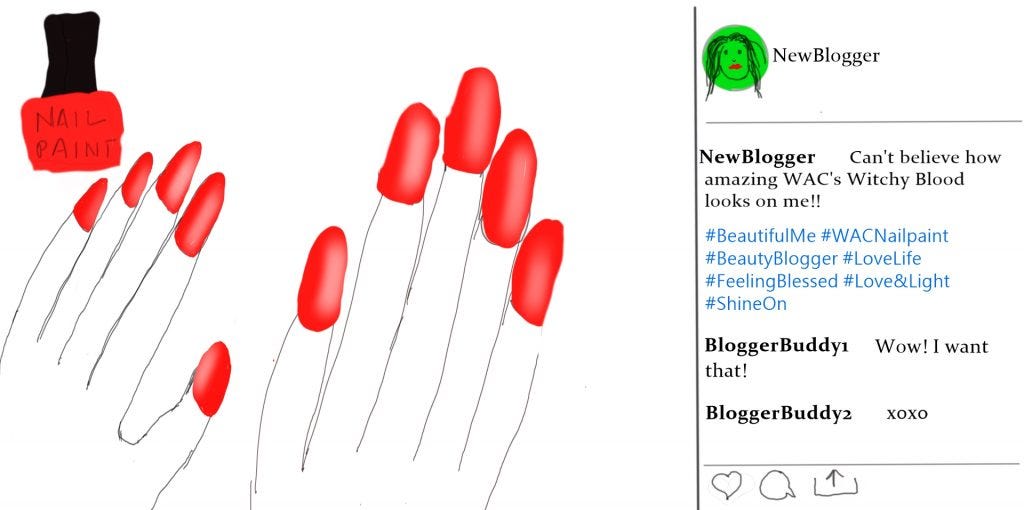
This ruffled a few feathers in the dynamics:
- It gave hope to people with routine-life to have more courage and adventure in their soul.
- The ‘lack of a purpose’ started pushing open the door that was initially slightly ajar.
- Simultaneously, another thing happened; brands took note of this, and more importantly, they took note of how the ‘followers’ responded to it.
The content industry was ‘niche’ at this point, and the brands prided themselves in hiring only *insert BIG NAME here* for their products and services. Therefore, the brands initially struggled to understand what to do with this girl from the street, who had a small crowd gathered around her to hear what she has to say. It was for the first time in its existence that the brand was having a direct brush with the real user. The reality was meeting the ‘aspirational value’ in its eyes.
Curious about this new marketing channel, the brands opened their backyard to these folks for ‘bloggers meet’. This also ensured that the entire thing didn’t spearhead into a direction which was less preferred by the brands. AND to see if there was a scope to maximize profits.
In these meets, the brands would invite the bloggers (back in the days one had to have a blog and a mere Instagram account wouldn’t do) and let them play. The bloggers and the brands, both were learning at the cost of each other.
The brands would give out free products to be written about but at the same time, maintained a cold distance from the content and its creator, never endorsing either.
At this point, the content was just enough for the market to consume; the demand and supply serviced each other with adequacy.
Since the brands didn’t wield the pen, them not endorsing the content and its creator was not much of a problem. Most of the bloggers had a small group of people they spoke to and were heard by, and it worked well for both the parties.
However, this freebie distribution system dumbed down the game by several notches, and the ‘niche’ turned into an ‘industry’ overnight. The ‘followers’ were no longer friends. They were stats. More followers meant even more freebies. And vice-versa.
Not only that, more the number of freebies, greater were your chances of getting more freebies; it became a vicious cycle of sorts. Therefore, came the need to buy a merchandise, and announce ‘look what came in the mail!! Thank you, *insert brand-name* so much!’ on social media. The idea was to get the ball of freebies rolling; some cracked it, some couldn’t.
The entire exercise costed nothing to the either of the parties; one was trading credibility in lieu of fame and the other was ‘getting fame’ in lieu of trust. Which was doing which, I leave for you to decide.
The brands were saving money and the ones who had never spoken earlier were getting heard. There were absolutely no complaints, what-so-ever.
Until the brands started asking for a ‘minimum followership’:
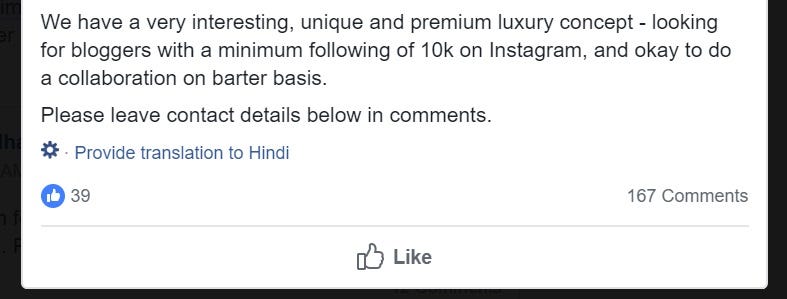
Which gave rise to this:
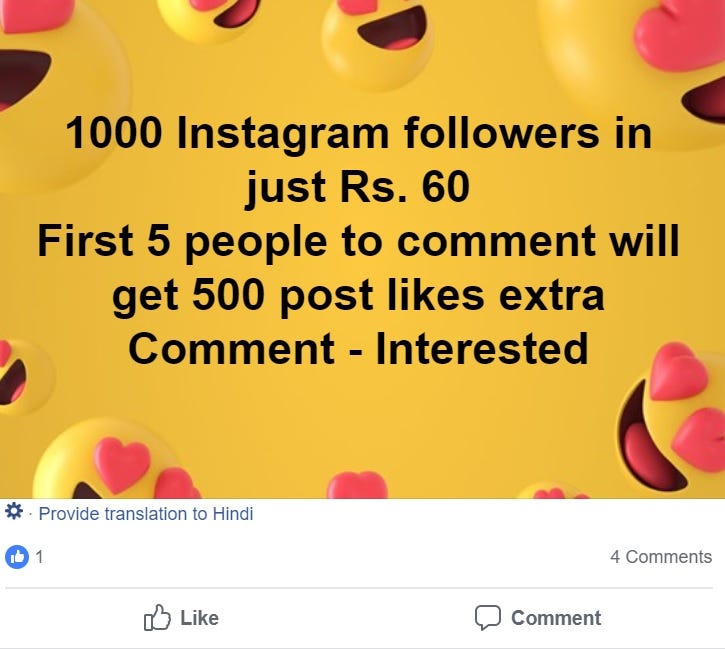
Apparently, the word was, some bloggers were getting paid for their blogposts and social media posts. With the introduction of money in the system, shit hit the roof! People, who had shied away from writing even the ‘acknowledgement’ page in the group projects in college, were now writing blog/s. The ones who didn’t know their silks from cottons, started talking about fashion trends. The ones who didn’t know the difference between prime and zoom lenses, started writing about which camera should be bought. The ones who could afford to drink only when the brand offered free liquor at the launch party, were suddenly the wine connoisseurs; so on and so forth. There was total mayhem in all spheres of existence! The ones who were REALLY knowledgeable about their sphere of work, were too stunned to react, and continued their existence in anonymity.
By now, the entire thing had gained momentum and almost everyone was strapped firmly on to their seats on the train to Nowhere. ‘Content is the king’ was hurled at anyone who tried to nitpick with the entire process. No one questioned anyone about ‘conversions’ and the impact this entire exercise had on the overall commerce. It was a business of credibility and ethics, and both are not easy to measure, irrespective of one’s experience.
That further lowered the level of game, and another sea of bloggers stormed into the ‘industry’.
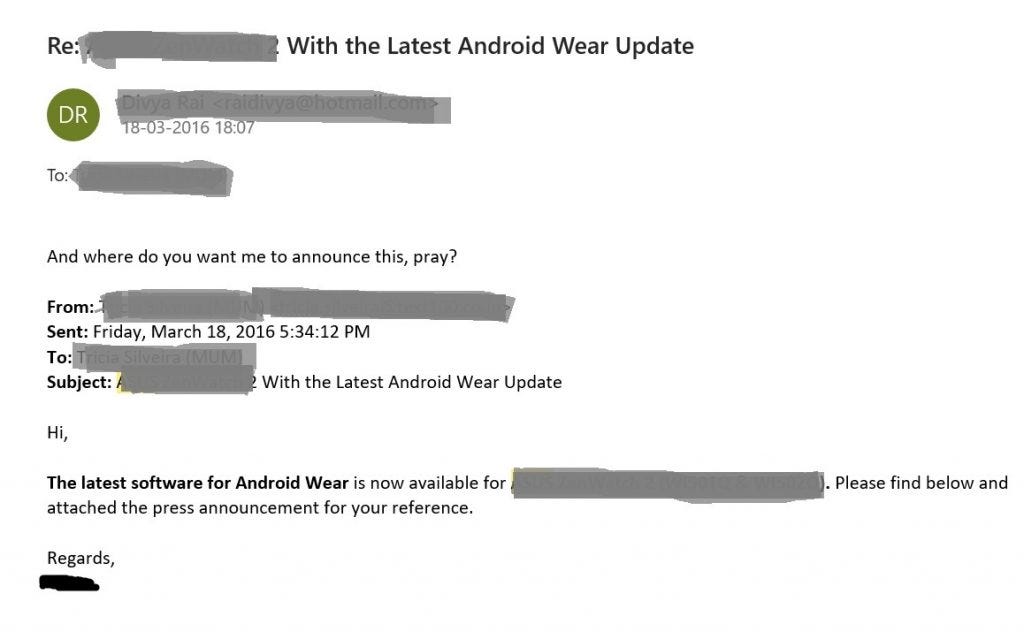
Instagram, FB posts and tweets were now slotted as ‘micro-blogging’ and from here two roads diverged into the woods;
- One, where the entire blog/social media-account was based on the blogger’s personality and who he/she was.
- Another, that rode on the content (mostly based on SEO, or one’s love for writing/niche). The former lasted as long as its creator was active, while the latter survived for a wee bit longer, depending on the niche.
Everyone produced content, and very few actually consumed it (except for ones family and friends maybe). No one asked anyone as to why a certain post was being made. The posts were being made, because they had to be made. The cacophony in the blogosphere was at its all time high!
With this, came a need for ‘engagement pods’ (engagement pods are the groups that inflate a post/blogs popularity artificially:
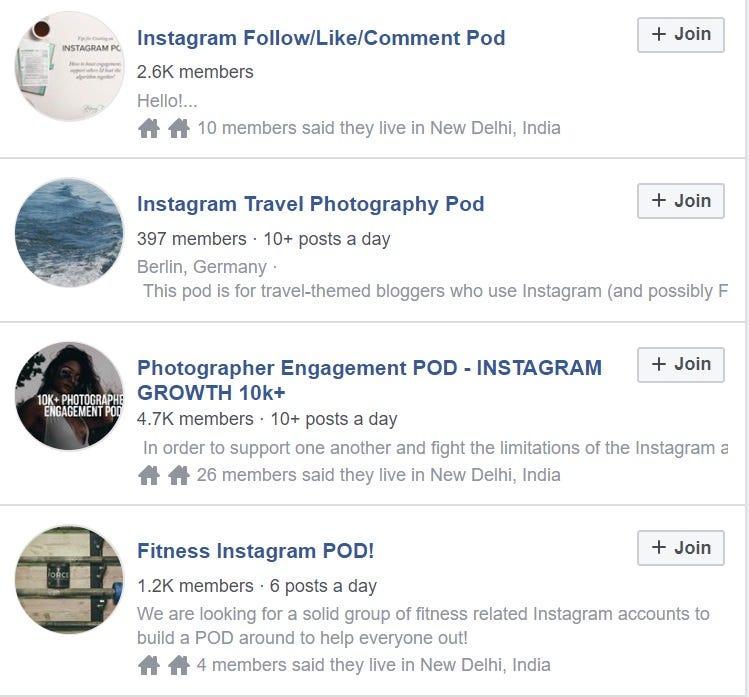
And this:
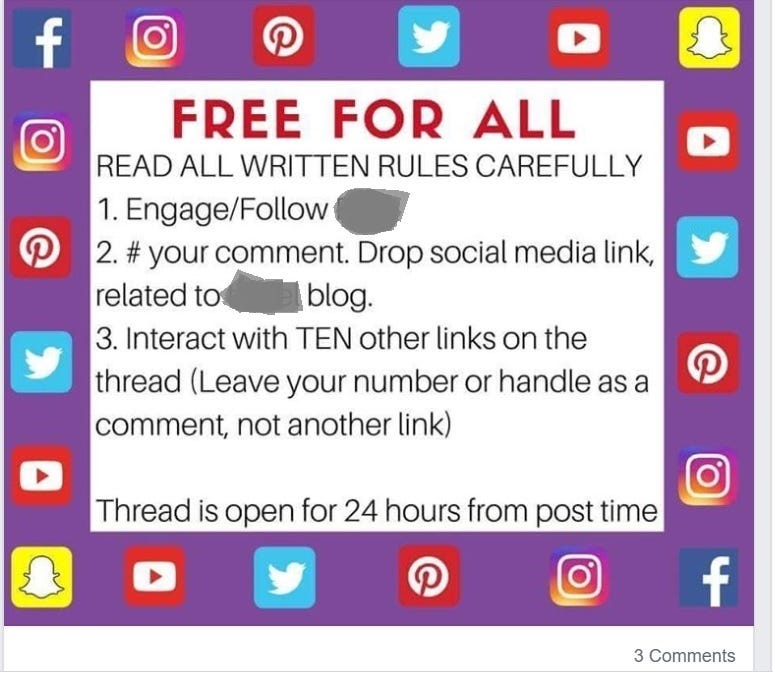
This, however, was needed.
Either because the readers read and left without a visible footprint, (stats aren’t a public information), or because the blog/account shouldn’t look like no one gives a flying f**k about it!
Unfortunately, very soon, the brands (the agencies, somehow, knew about it all along, but were hands-in-glove with the bloggers regarding this, as it suited their purpose) got a whiff about this ‘dressing up’. Their trust in the stats got shaken a bit.
Then came this:
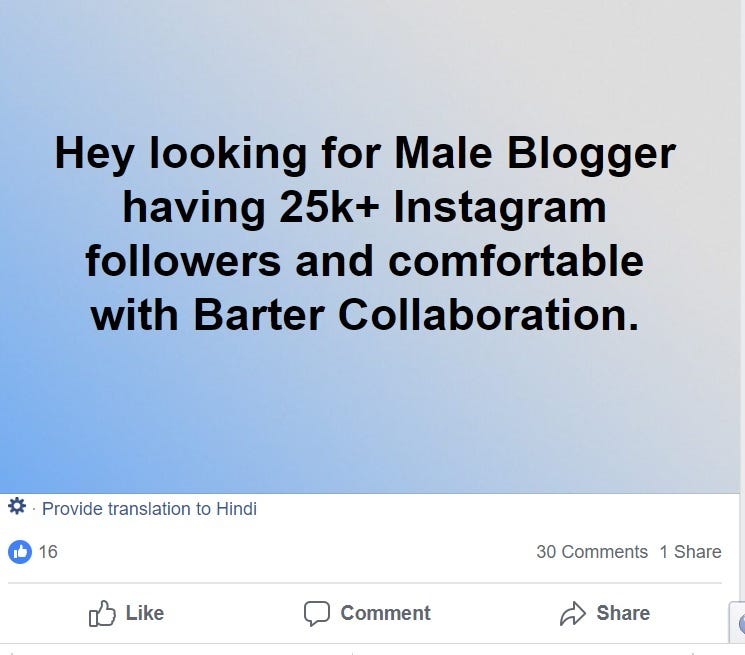
The tables had turned suddenly, and the brands started seeking freebies from the bloggers. Money started drying up, because there WAS no money in the first place. It wasn’t anything that would turn into a sustainable income (I am talking masses here); only something that met expenditures at the most, or be a side-income. It wasn’t something that ever saw big budgets being earmarked for it, because the entire thing laid between advertising and PR and borrowed worst (for the blogger, not the brands) from both the worlds. Moreover, the sales-sheet did not corroborate the plethora of freebies that were being doled out at alarming frequency.
With the advent of money, the brands felt the need (and the entitlement) to control what was being written about them. Blogs were the new marketing channel that could get the word floated around easily, and at low cost. And thence came the point where the brands would tell the blogger as to what is to be said. The blogger was reduced to being a mouthpiece, and a brain was no longer needed. Also, the brands started preferring people who would write just about anything they were told to, and not pass their judgement. The ones who liked to critique, saw a decline in the number of offers made to them.
With the brands wielding the pen, things graduated to a newer low (this exchanged of email happened between a brand and a blogger I happen to know through social media):
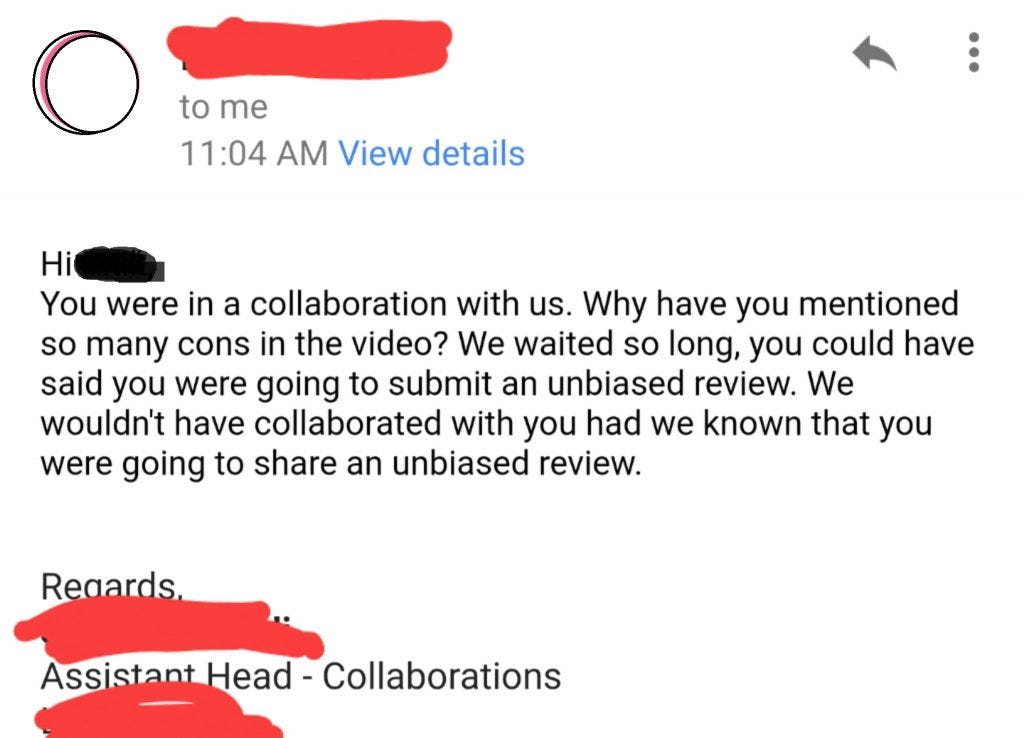
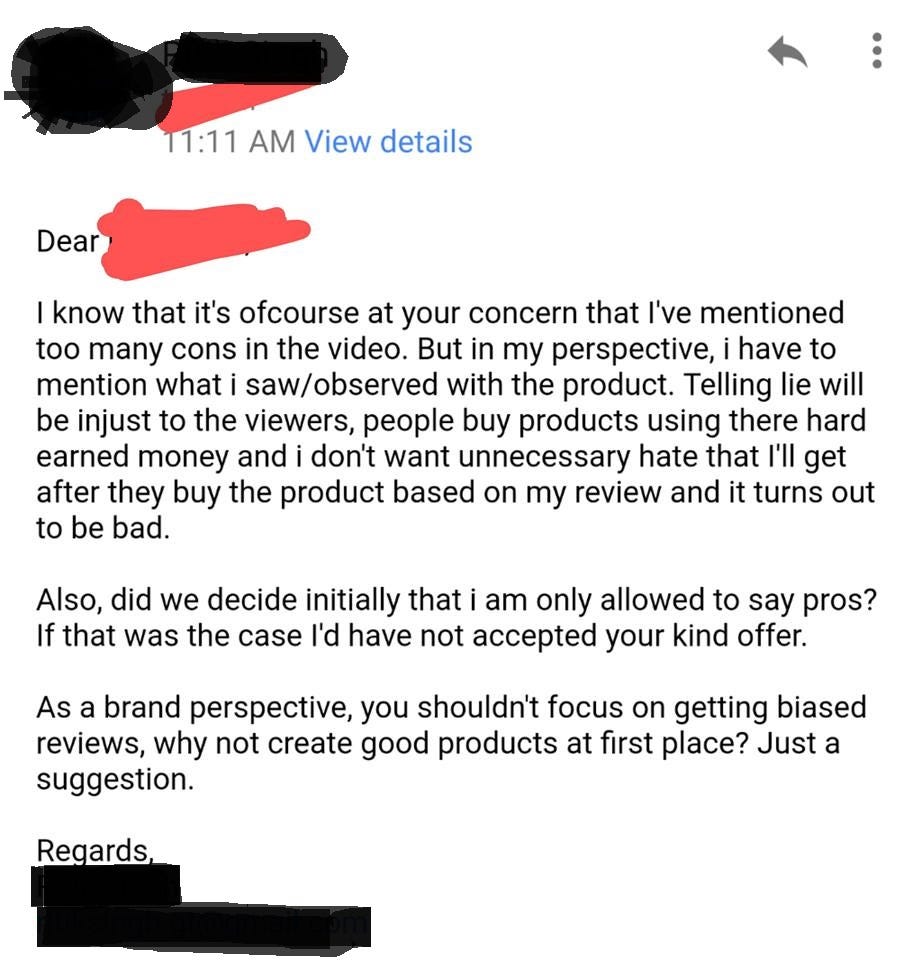
By this point in time, the bloggers were endorsing anything and everything, and had lost complete trust of the reader, well almost. By now, the brands were being endorsed by just about anyone, well almost.
The question to ask is, what next?
Very Well articulated Divya. I really admire your honesty and boldness to say what you feel right in this world of consumerism where brands are really misusing blogging community. Bloggers need to decide what they want – Trust for their blogs or losing trust of their followers for building trust for brands !! Sustainable future is in the hands of community of bloggers.
Hi Saurabh,
Thanks for the kind words.
🙂